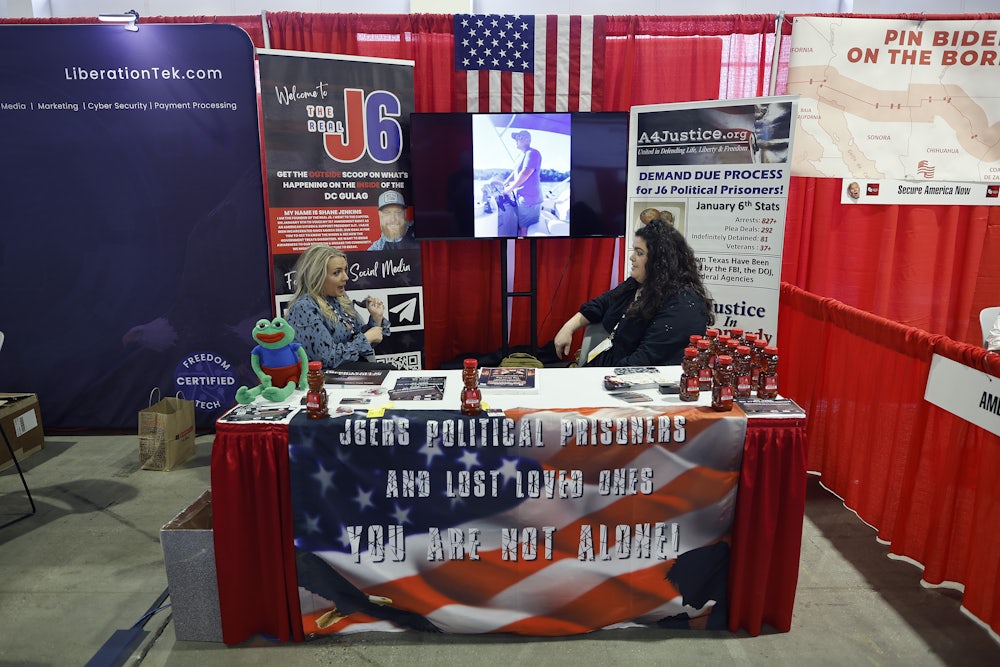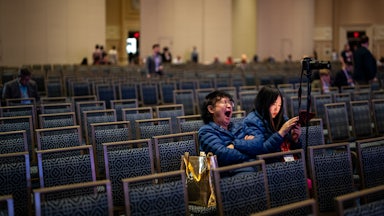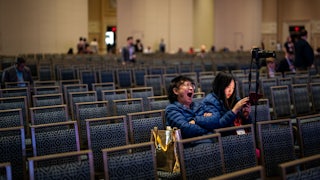The January 6 vigil gathers every evening at the end of E Street, next to the cemetery. They have pie. There are homemade skewers of meat and olives and a bowl of strawberries on hand. A man wearing a tricorn hat beats the hell out of a slung snare drum–cowbell combo while his companion’s guitar screeches, “We’re Not Gonna Take It” by Twisted Sister. A woman a little ways away from the band dances ecstatically with an American flag, eyes closed and face upturned—perhaps to God; definitely to the brutalist bulk of the D.C. Central Detention Facility that looms just down the road. Inside, approximately 40 January 6 prisoners await trial. Many have waited for over two years.
Eventually, the music dies down and this crowd of perhaps 35 grows quiet. “Today is day number 783 of the Jan. 6 political hostage crisis,” a man intones. “Every single night we say their names. Bear with me: This list is pretty long.” It takes him over three minutes to get through everyone. The crowd somberly intones “hero” in the space between each name. They are mostly middle-aged, mostly white or Asian, and many wear identical white T-shirts with a portrait of a smiling woman in a beanie on the back.
“So let’s say her name,” the man says once he’s finished with the list. The crowd roars to life and chants in unison the name above the woman on their T-shirts, over and over: “Ashli Babbitt! Ashli Babbitt!”
After 25 Ashli Babbitts, loudspeakers begin to play a basic hook as a man with facial tattoos and a beard that ends at the corners of his mouth steps forward. “All right, get your hands up, here comes Ashli Babbitt!” This, as it turns out, is not an introduction to a miracle, but the name of a rap song he clearly performs often. The crowd bobs arhythmically, the flag dancer resumes, the rapper, who goes by Forgiato Blow, drops dubious bars:
Ashli Babbitt, yeah you know we hold you in prayer,
Ashli Babbit, yeah your soul’s in the air.
Ashli Babbit, yeah you know true patriots care—
Blood on the battleground: Life isn’t fair!
I am approached almost immediately by someone who asks if I’m a journalist and, shortly after that, by a man who introduces himself as Randy Ireland. Ireland is the founder of Americans for Justice, along with a few other things we’ll get to later, and he is more than happy to chat. This group has held vigils for the January 6 prisoners since August 2022. It’s a matter of due process. Two years waiting for trial in abysmal conditions, he says, should outrage everyone.
“Politics should never enter the equation in meting out justice,” Ireland tells me, two days later at his booth in CPAC Central. “When politics start influencing our justice system, we’re all losers because it never stops.”
January 6 is a subject still hot to the touch. As with the last two Conservative Political Action Conferences, the legal plights of those who participated in the attack on the U.S. Capitol found sympathetic but limited purchase on the main stage and slightly more attention on the periphery of the conference. But there’s been a shift in tone this year: something beyond both conspiratorial claims of federal incitement and concerns over the treatment of the prisoners within America’s carceral nightmare. It’s the word “hero” between the names that’s new. It’s the worst rap lyrics you’ve ever heard. It’s the active canonization of the fallen; worship of the ones still alive and oppressed. Slowly, inexorably, the J6 Cult of Martyrs is finding a place within the mainstream conservative pantheon. All of this has happened before: Once that mythos settles in, it will surely happen again.
“We now have nearly a thousand people who’ve been charged related to their involvement in January 6,” Julie Kelly says from the CPAC stage during the 9 a.m. time slot: nosebleed booking but the main stage nonetheless. Her manual for the new school of thought on the riot, January 6: How Democrats Used the Capitol Protest to Launch a War on Terror Against the Political Right, dropped in December 2021. These charges, she says, are “mostly low-level misdemeanors that nonetheless have destroyed their lives, ruined their families, bankrupted and alienated them from their own communities because they’re considered domestic terrorists.”
According to the George Washington Program on Extremism, the FBI has arrested 940 people in connection to January 6. Of those, 43 were convicted, 481 pleaded guilty, and 382 are still waiting for trial. Most of the people waiting are out on bail. Some, however, are waiting within a prison cell; some for more than two years. The D.C. prison holds approximately 40 such prisoners. There may be more elsewhere; the government offers no clear answers.
By now, 26 months have passed since January 6, 2021; it’s safe to say these prisoners did not receive a speedy trial. They also allege inhumane prison conditions, abusive guards, and general cruelty. In October, 35 of the detainees decided to call attention to their plight in the most annoying way possible: They petitioned a federal court for a transfer to Guantánamo Bay.
The notion that the site of America’s most infamous torture program would be more humane than the “D.C. Gulag” is both ridiculous and insulting, but it does not negate the underlying complaint. In 2021, Senators Elizabeth Warren and Bob Casey joined the ACLU in denouncing extended solitary confinement for J6 detainees as “torture.” As early as seven months after the first arrests, judges began to express concern over the amount of time between indictment and trial—a problem caused by the sheer bulk of evidence involved in these cases.
In another bid to raise awareness, Jonathan Mellis filmed and tweeted a video in which he complains about what he sees as lenient treatment of Black Lives Matter protesters, while filling a water bottle from his cell sink. “We deal with black mold, brown drinking water, rats, and cockroaches,” he says. “I wouldn’t wish this on my worst enemy.” When he finishes filling the bottle from his cell’s only apparent water source, he holds it to the light; it is the color of rust, undrinkable.
When Ireland told me that prison guards cut rations for the J6 prisoners in retribution for his group’s protests against the prisoners’ poor treatment, I was skeptical. But a federal investigation into the D.C. facility found that guards often withheld food for punitive reasons. Inspectors found several other problems, including sewage and water leaks, things activists for the mostly Black prison population had complained about for years. These findings led to the transfer of 300 prisoners from older areas of the jail. Dire as it sounds, the J6 rioters turned out to be the lucky ones.
Ireland acknowledges the wider problem within the carceral system and says he hopes activism around the J6 prisoners can help. “There are obvious abuses that had been going on long before J6,” he says. “And sadly, many of us are just waking up to that now.”
It’s a good story, but I’m not sure how far “us” really goes. As CPAC continues, I hear about the plight of the J6 prisoners semi-regularly. And yet, aside from this one-on-one conversation between an organization leader and a self-confessed lefty journo, I hear no further mention of prison reform more broadly, onstage or off.
What I do hear, constantly and relentlessly, is proclamations of innocence. Nearly every discussion of January 6 involves a brief obligatory disclaimer: Sure, yes, people who actually broke the law should be prosecuted to the fullest extent. In this telling, however, it is difficult to determine who those people might be. “I went to the Capitol on January 6th to voice my 1st amendment right as an American citizen & support President DJT,” prisoner Shane Jenkins writes in the “About” section of his activist group’s site, The Real J6. The website does not mention footage that clearly shows him breaking a window with a tomahawk. Similarly, Mellius claims in his water video to have “witnessed the murder” of Rosanne Boyland: a woman who lost consciousness, possibly as a result of amphetamine overdose, and was trampled to death by her fellow protesters. However, video shows him trampling Boyland as she lay dying in order to beat a police officer with a hockey stick.
As I learn these stories, I can’t stop thinking about that word from the vigil: hero. Americans for Justice read the name of everyone currently incarcerated, not just people waiting for trial. This list included Oath Keeper founder Stewart Rhodes, who was found guilty of seditious conspiracy for, among other things, bringing a cache of weapons to an Arlington hotel in case the operation turned into a shooting war. It included Dominic Pezzola, a Proud Boy who shattered a Capitol building window with a policeman’s riot shield and was one of the first people to enter the building. And it included Ethan Nordean, Joe Biggs, and Enrique Tarrio, Proud Boy leaders who conspired via text to have their group take the Capitol building.* Tarrio, while not physically present on January 6, met with the Oath Keepers the night before the Capitol invasion and participated heavily in planning.
These people do not seem like heroes to me. So I asked Ireland about it.
Ireland’s voice hardens. “Why isn’t he a hero?”
“Well, I guess I’m asking—I’d like to know why you think he is.”
Ireland answers that it’s not his group’s place to judge. Besides, he says, Tarrio is his friend, and the Proud Boy wasn’t even in D.C. on January 6.
I keep pushing: There’s a big difference between someone who deserves due process and a hero, I say. That’s a bit of a leap, don’t you think?
Ireland talks a bit about the suffering all these people have endured, then finally answers the question. “They had the courage to stand up for what they believed in. And now [they’re] being politically persecuted for it.”
It makes sense that Ireland would feel this way. When he says that Tarrio is his friend, what he means is that he was once the head of the Hell’s Gate Bridge chapter of the Proud Boys out in New York. Ireland authored a 23-page manual on how to coordinate and execute large marches, including the formation of tactical and scout teams, and how to neutralize threats. The manual was last modified on January 5, 2021.
As of September 28, 2022, Ireland claims to no longer be affiliated with the Proud Boys. But he was still very much a part of the group on August 22, weeks after Americans for Justice began to hold vigils. Ireland spoke at the Proud Boys “Summer of Love” rally in Portland, Oregon, on August 22, weeks after the J6 vigils began. This event turned violent when a van entered the abandoned K-Mart parking lot where Proud Boys had set up shop. Members of the so-called drinking fraternity rushed the van and broke the windows with baseball bats. When the women inside attempted to run away, Proud Boys pursued them and beat them, then tipped the van over. Members of the group then left the parking lot to assault other cars and shoot paintballs at passersby.
In a small conference room packed to the walls, #WalkAway founder Brandon Straka asks each of his fellow panel members to describe their experience at the Capitol building on January 6, 2021. Everyone who was present on that day claims they saw no violence, including Straka himself.
Footage Straka posted to social media immediately after the assault suggests otherwise. The eight-minute video, quickly deleted, shows rioters ripping a riot shield out of a police officer’s hands. A male voice yells, “Take it!”
Straka strenuously denied that the voice was his, but eventually pleaded guilty to avoid a multiyear prison sentence. As part of the plea, he had to sign an affidavit confessing the voice was his. I have watched the video several times, and I am not so sure. Though clearly excited, Straka did not enter the Capitol building and committed no acts of violence. He’s no hero, but he doesn’t seem like much of a villain either.
The activist’s conviction seems to stem as much from his actions before and after January 6 as on the day itself. During a speech on January 5, he welcomed patriots to the revolution. After the rally, he exhibited no remorse. “I’m completely confused,” he tweeted. “For 6-8 weeks everybody on the right has been saying ‘1776!’ & that if congress moves forward it will mean a revolution! So congress moves forward. Patriots storm the Capitol—now everybody is virtue signaling their embarrassment that this happened.”
Last August, Straka sat down with me for an interview. One of the things he said has haunted me ever since:
“Even if you don’t agree, don’t you understand? The people who were upset thought the election was being stolen. Now you think that the election was being stolen [by Trump] and you’re enraged. You don’t have to agree with us,” Straka says, “but what you’re feeling is what we were feeling.”
If there is heroism to be found in the crowds of rioters who broke into the Capitol and ransacked Pelosi’s office and searched the chambers of Congress for proof of malfeasance, it is surely this: People like Straka believed they were saving democracy from tyranny. They did not make this story up. This story was told to them, by people they trusted, for months.
The FBI has made nearly a thousand arrests, and with the exception of people like Rhodes and the Proud Boy leadership, all of them were cannon fodder: regular people who believed a lie. We threw away the bullets but left the gun untouched. For every thousand foot soldiers you arrest, another thousand can instantly take their place, especially if you make the fallen into martyrs.
Meanwhile, not one person who propagated lies about the election or encouraged revolution has suffered consequences for their actions. We now know that both Rupert Murdoch and Fox News personalities believed the election hoax was a lie but propagated it anyway for ratings—to keep the gravy train rolling. Fox News’s revenue dropped precipitously after it called Arizona for Trump but ultimately went up by over 8 percent during 2021, after the network embraced the Big Lie. Murdoch and Hannity and Tucker remain wealthy, while the people who listened to them rot in prison. Trump, infamously, remains untouched, as does every grifter and sycophant who manufactured evidence for their own personal gain.
You can arrest the guy who broke a window, but the true architects of January 6 are elusive and multitudinous. No one person laid the kindling that made this conflagration possible. It happened over years, maybe decades, of the exact kind of ramped-up rhetoric, language of division, dehumanization, and fearmongering still peddled from the main stage of CPAC. It scares people into voting. It scares them into watching and clicking. It scares them into doing much worse.
Conservative elites. They looked at January 6, saw their own handiwork, and chose to continue the project. For the last two years they’ve stacked the kindling even higher, stoking fear while further demonizing the left in a desperate attempt to regain power.
And it’s working.
I spent over an hour at Randy Ireland’s table during our interview, not because we talked the whole time but because he kept needing to take breaks to deal with the steady stream of people who came over and expressed sympathy with his cause. Many said they were there on J6. They shared stories. Bought T-shirts. Thanked each other.
Only one of these well-wishers—a young man—did not approve of January 6, because he believed it didn’t go far enough
“It was back in 2012 when we Ron Paul people were screaming at everybody about the debt bullshit,” he said. “And here we are, 10 years later … still fighting the same dumbass battles and more debt. And it’s unfortunate, but it’s gonna have to end in a little revolution. The country was founded upon January 6.”
* This article originally misidentified Joe Biggs.










